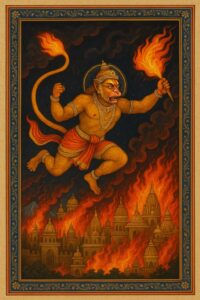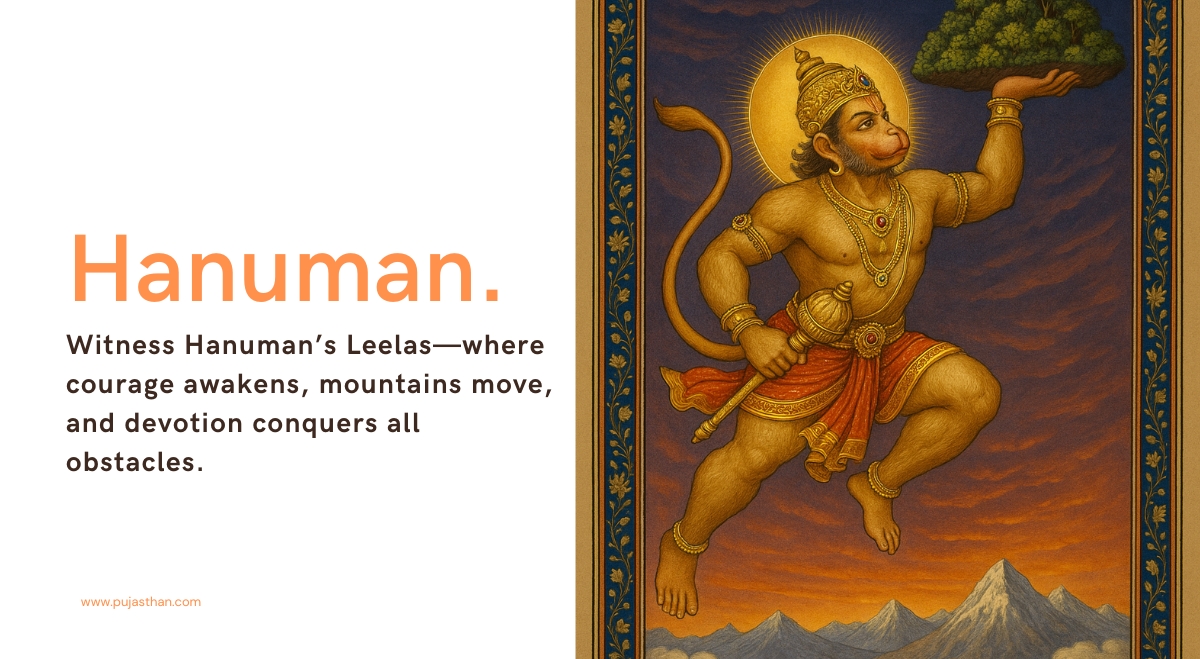In the vast ocean of Sanatana Dharma, the concept of Leela represents the divine play—acts performed not out of necessity but as expressions of cosmic love, service, and transcendence.
Among the many deities revered for their Leelas, Hanuman stands apart. His acts, woven across scriptures, folk tales, and oral traditions, are not just feats of strength—they are living lessons in courage, selflessness, and unwavering devotion.
From leaping across oceans to carrying mountains, Hanuman’s Leelas teach us that:
When fueled by devotion, the impossible becomes possible.
This article explores Hanuman’s most celebrated Leelas, uncovering their spiritual significance and timeless inspiration for devotees across the world.
The Birth of Hanuman – A Divine Prelude to His Leelas
Every Leela has a divine beginning, and Hanuman’s birth itself is a miracle steeped in cosmic significance.
Anjana’s Tapasya and the Blessings of the Gods
Anjana, a celestial being cursed to be born on Earth, performed intense Tapasya (spiritual penance) for deliverance. Pleased with her devotion, Vayu Deva, the Wind God, and Lord Shiva blessed her with a divine child, Hanuman.
This birth isn’t merely mythological—it represents:
- Pranic energy (Vayu) gives life and vitality
- Shiva’s essence merges with devotion
- The embodiment of cosmic strength is aligned with humility
From the moment of his birth, Hanuman’s destiny was intertwined with serving the greater good—a theme central to all his Leelas.
Hanuman Leaping for the Sun – The First Display of Courage
As a child, Hanuman’s boundless energy and innocence led to his first cosmic act. Mistaking the rising sun for a fruit, he leapt across the sky to seize it.
Symbolism and Spiritual Significance:
- Represents the innate, untamed potential within every being
- The courage to reach for greatness, even at a young age
- The consequences of unchecked energy: Indra’s thunderbolt and Hanuman’s jaw injury
Yet, the gods blessed Hanuman with:
- Immunity from harm
- Strength beyond measure
- Eternal protection
Thus, even his childhood mischief became a divine Leela, teaching that true strength arises through learning, blessings, and resilience.
Hanuman’s Role in the Ramayana – The Pinnacle of His Leelas
Hanuman’s most celebrated acts unfold within the epic Ramayana, particularly the Sundara Kanda, entirely dedicated to his heroic journey.
Meeting Rama – The Divine Connection Begins
When Hanuman first encounters Rama, it’s not by accident—it’s destiny aligning devotion with divinity.
In their meeting:
- Hanuman recognizes Rama as the Supreme
- Rama recognizes Hanuman as his perfect Sevak (servant).
This Leela symbolizes:
- The meeting of the individual soul (Hanuman) with the Supreme soul (Rama)
- The power of humility and service in spiritual awakening
Hanuman Crossing the Ocean to Lanka – Overcoming the Impossible
Tasked with finding Sita, Hanuman performs his iconic leap across the ocean, embodying:
- Courage beyond limitation
- Mastery over the elements
- Faith transforming obstacles into opportunities
The leap isn’t just physical—it represents transcending inner doubts, fears, and ego through devotion.
Finding Sita Devi – Messenger of Hope and Devotion
Locating Sita in Ashok Vatika, Hanuman reassures her of Rama’s love and determination.
This Leela reflects:
- The Bhakta as the messenger of divine hope
- The power of words infused with faith
- Hanuman’s role as the bridge between suffering and salvation
Burning Lanka – Fearlessness and Dharma Enforcement

Captured and humiliated by Ravana, Hanuman uses his burning tail to set Lanka ablaze, sparing only sacred spaces.
His act teaches:
- Destruction of evil, not out of vengeance, but to uphold Dharma
- Courage under captivity
- Devotion as the source of righteous power
Carrying the Sanjeevani Mountain – Selfless Service for Healing
When Lakshmana lies wounded, Hanuman flies to the Himalayas. Unable to identify the life-saving herb, he carries the entire mountain.
This Leela exemplifies:
- The lengths a devotee goes to serve
- Strength guided by humility and love
- The potential within each being to be a healer and protector
Hanuman’s Leelas Beyond the Ramayana – Mahabharata and Puranas
Hanuman’s Leelas transcend the Ramayana, flowing into other sacred texts like the Mahabharata and Puranas, where his divine acts continue to inspire.
Humbling Bhima in the Mahabharata
In the Mahabharata, Hanuman encounters Bhima, the mighty Pandava prince and son of Vayu (just like Hanuman).
Bhima, proud of his strength, journeys through the forest, boasting of his abilities. He encounters an old monkey (Hanuman in disguise) lying across his path. Bhima arrogantly demands that the monkey move, but when he fails to lift the tail, his pride dissolves.
Symbolism of the Leela:
- Strength without humility is incomplete.
- Hanuman’s mastery surpasses even the greatest warriors.
- True power lies in inner control and devotion.
Hanuman blesses Bhima, ensuring victory in his righteous battles and symbolically uniting strength with service.
Hanuman’s Blessings to Arjuna
In another Mahabharata episode, Hanuman blesses Arjuna, agreeing to adorn his chariot’s flag (the Kapi Dhwaja) during the Kurukshetra war.
Significance:
- Hanuman’s presence ensures protection and divine strength.
- Represents unbreakable devotion transcending time
- Unity of Bhakti and Dharma in action
The flag bearing Hanuman reminds devotees that courage, guided by devotion, conquers even the darkest challenges.
Puranic Legends of Eternal Protection
The Puranas, particularly the Skanda Purana and Shiva Purana, narrate Hanuman’s ongoing Leelas:
- Protecting sacred spaces from demonic forces
- Guiding sages and yogis in spiritual practices
- Assisting those who chant his names with sincerity
These stories affirm that Hanuman’s Leelas didn’t end with Rama’s earthly life—they continue, subtly guiding and protecting seekers.
Panchamukhi Hanuman Leela – The Rescue from the Netherworld
One of Hanuman’s most mystical Leelas unfolds during the battle to rescue Rama and Lakshmana from the demon Ahiravana, ruler of the netherworld (Patala Loka).
To defeat Ahiravana’s dark magic, Hanuman assumes the form of Panchamukhi Hanuman—the five-faced protector.
Faces and Symbolism:
| Face | Represents |
|---|---|
| Hanuman | Courage, devotion, selfless service |
| Narasimha | Ferocity in destroying evil |
| Garuda | Mastery over negative energies |
| Varaha | Upliftment and protection of the Earth |
| Hayagriva | Supreme knowledge and spiritual victory |
In this Leela:
- Hanuman extinguishes the five lamps sustaining Ahiravana’s power.
- Rescues Rama and Lakshmana, restoring balance
Deeper Meaning:
- Triumph over darkness through integrated divine qualities
- Protection in all directions—physical, mental, spiritual
- The Bhakta’s evolution into a comprehensive protector
Panchamukhi Hanuman remains a revered form for overcoming severe obstacles and invoking multidimensional strength.
Hanuman as a Chiranjeevi – His Ongoing Leelas in Kali Yuga
Hanuman’s most subtle yet significant Leela is his Chiranjeevi status—immortal, eternally present on Earth to aid devotees.
Hanuman’s Invisible Acts of Protection
Devotees believe:
- Hanuman intervenes during crises, protecting sincere seekers
- His invisible presence shields from negative forces.
- His grace uplifts those chanting his names.
Across regions, countless modern stories echo:
- Miraculous escapes from danger
- Healing from severe illness after Hanuman worship
- Spiritual guidance during emotional turmoil
These experiences aren’t mere coincidences—they reflect Hanuman’s ongoing Leela of serving and protecting in Kali Yuga.
Hanuman Jayanti – Celebrating His Eternal Leelas
Hanuman Jayanti, marking his divine appearance, is celebrated with:
- Recitation of Hanuman Chalisa
- Devotional processions and rituals
- Acts of charity and service
This day reminds devotees:
- Hanuman’s Leelas continue
- Sincere Bhakti invokes his blessings
- His strength resides within every devotee.
The Spiritual Message of Hanuman’s Leelas for Devotees
Hanuman’s Leelas transcend mythology—they serve as guiding lights for:
- Overcoming inner and outer obstacles
- Serving with humility, not ego
- Cultivating unwavering devotion and courage
Lessons from Hanuman’s Leelas:
- Strength flows from selflessness
- Devotion empowers impossible achievements
- Fear dissolves through surrender to the Divine
- True service uplifts the world
By reflecting on Hanuman’s acts, devotees awaken:
- Inner courage
- Spiritual discipline
- Unshakeable Bhakti
In every challenge, Hanuman’s Leelas whisper:
With faith, all obstacles become opportunities for divine expression.
Conclusion – Living Hanuman’s Leelas Through Bhakti and Service
Hanuman’s Leelas aren’t relics of ancient texts—they’re timeless calls to action.
Every time:
- You face fears with courage
- Serve others selflessly
- Chant Hanuman’s names with love
- Overcome doubt through devotion
You participate in Hanuman’s ongoing Leela, transforming your life into a reflection of divine service.
Let Hanuman’s acts inspire:
- Strength beyond limits
- Devotion beyond doubts
- Service beyond self
In the rhythm of his Leelas, find your courage, purpose, and spiritual fulfillment.
FAQs About Hanuman’s Divine Acts and Stories
Q1: What is the meaning of Leela in Hanuman’s life?
Leela refers to Hanuman’s divine acts, performed not out of necessity but as expressions of love, devotion, and spiritual instruction.
Q2: Which is Hanuman’s most famous Leela?
Leaping across the ocean to Lanka in search of Sita and carrying the Sanjeevani Mountain to save Lakshmana are his most iconic Leelas.
Q3: Is Hanuman still performing Leelas today?
Yes, as a Chiranjeevi, Hanuman’s subtle acts of protection, guidance, and strength continue, especially for sincere devotees.
Q4: What does the Panchamukhi Hanuman Leela teach us?
It symbolizes overcoming severe obstacles by integrating courage, knowledge, and divine protection from all directions.
Q5: How can devotees connect with Hanuman’s Leelas in daily life?
By cultivating courage, selfless service, chanting his names, and facing challenges with devotion, devotees live Hanuman’s Leelas every day.

